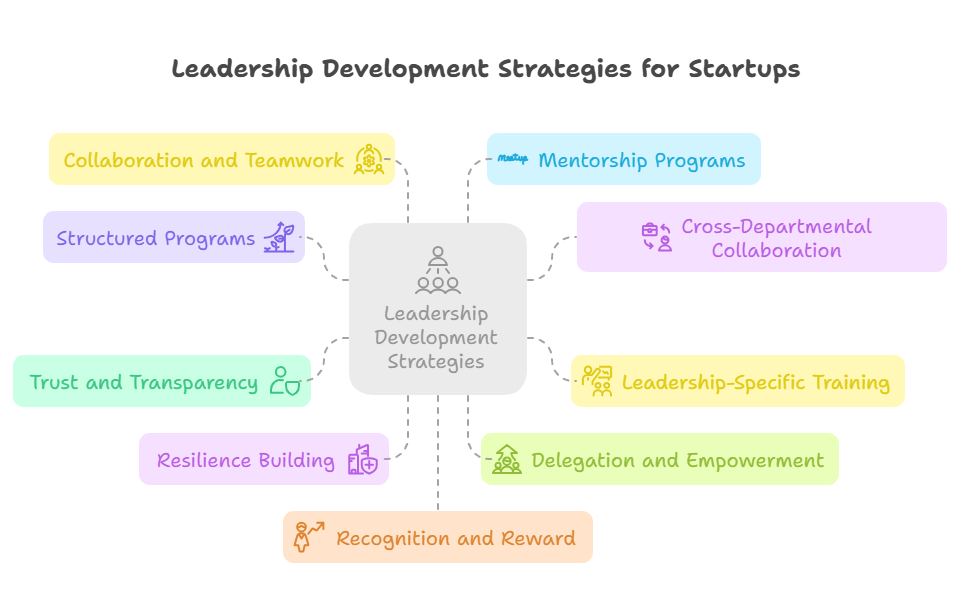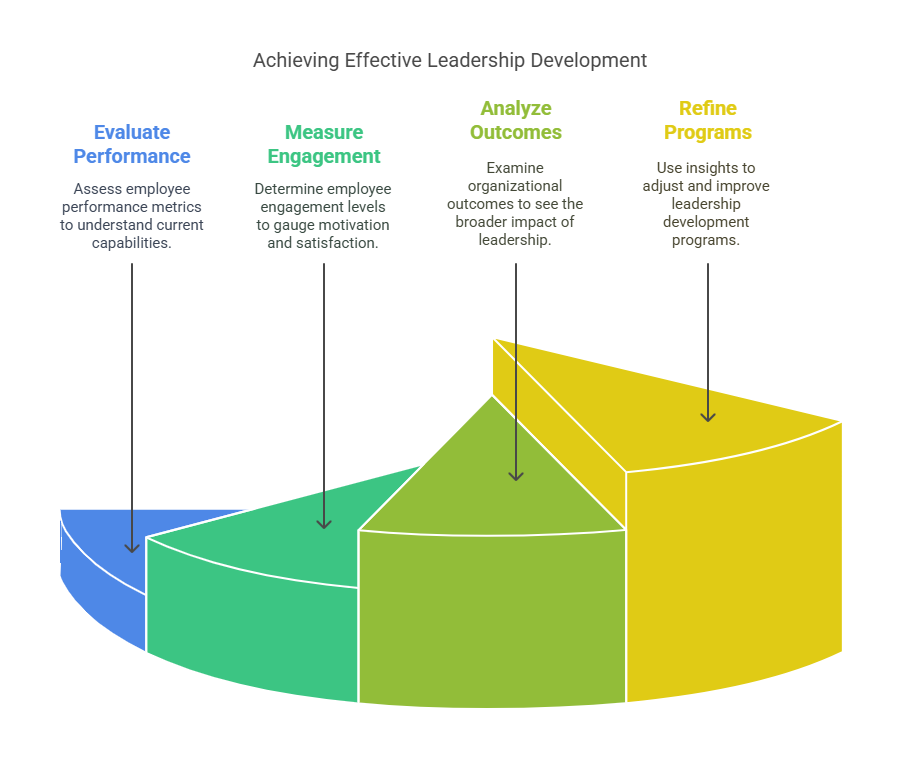Every successful startup needs strong leadership. Whether you’re just getting started or scaling fast, having the right people in leadership roles can make all the difference. Great leaders help teams stay focused, make smart decisions, and keep things moving even during uncertainty.
The good news? Leadership isn’t just something you’re born with it can be learned and developed. With the right strategies, startups can nurture confident, capable leaders who drive innovation, guide teams, and support long-term growth.
In this guide, we’ll explore the top leadership development strategies for startups. From mentorship and coaching to hands-on projects and workshops, these proven approaches can help you build a strong leadership foundation for your company.
Why Top Leadership Development Strategies for Startups

In the early stages of a startup, leadership can make or break the company. Strong leadership is more than just having a title it’s about creating an environment where your team can thrive, adapt, and work toward a shared vision. Here’s why leadership development is essential for startups:
Guides the Team Through Uncertainty
Startups are often unpredictable, with constant changes and challenges. Effective leadership helps navigate these uncertain waters, making sure the team stays focused, resilient, and aligned with the company’s vision.
Builds a Strong Company Culture
Leadership shapes the culture of a startup. A good leader sets the tone for how the team collaborates, solves problems, and approaches challenges. Leadership development ensures that leaders understand how to create a positive, inclusive, and productive environment that attracts top talent and keeps the team engaged.
Improves Decision-Making and Strategy
As a startup grows, decisions become more complex. Leadership development helps ensure that leaders are equipped to make thoughtful, data-driven decisions that align with long-term goals and can adapt quickly when things don’t go as planned.
Increases Team Motivation and Retention
Strong leadership keeps the team motivated, engaged, and focused on the company’s mission. A well-developed leader knows how to inspire trust, manage conflicts, and give feedback, which are crucial for retaining top talent in a competitive startup environment.
Fosters Innovation and Growth
Leaders in startups aren’t just managers they’re innovators. Leadership development encourages leaders to be forward-thinking, empowering them to drive new ideas, solutions, and strategies that can push the company forward in a crowded market.
Prepares for Scaling
As startups grow, so does the complexity of managing teams, operations, and strategies. Leadership development ensures that founders and managers are ready to scale their leadership abilities to match the demands of a larger, more complex organization.
Top 9 Leadership Development Strategies for Startups
In the fast-paced world of startups, leadership is often the difference between growth and stagnation. Great leadership isn’t just about making decisions it’s about developing a culture of empowerment, innovation, and resilience across the entire organization. Here are 10 effective strategies to develop leadership from within your startup and ensure long-term success.

Create a Leadership Development Program
Why It Matters: A structured leadership development program sets the tone for the growth of your leaders. Without clear pathways, employees may not know how to take on leadership roles or advance their careers in the startup.
How to Do It: Start by mapping out a leadership curriculum that spans key areas like strategic thinking, communication, emotional intelligence, and conflict resolution. Offer various forms of learning workshops, online courses, or shadowing senior leaders. Make sure the program is ongoing, with a clear progression from entry-level leadership roles to more senior positions. By investing in structured learning, you ensure your team has the necessary skills to take on new challenges as the company grows.
Encourage Cross-Departmental Collaboration
Why It Matters: When future leaders are exposed to different areas of the business, they gain a holistic understanding of how the organization operates. This broadens their problem-solving skills and prepares them for leadership roles that require strategic thinking across multiple domains.
How to Do It: Implement job rotations or short-term projects where employees work with teams outside of their usual department. For example, someone from marketing might collaborate with product development to understand the integration of customer feedback in design. By exposing emerging leaders to different perspectives, you enhance their ability to think critically and lead across diverse teams.
Provide Leadership-Specific Training
Why It Matters: While technical skills are essential, leadership skills are what truly drive results in a startup. Training ensures that team members are equipped with the necessary tools to manage people, navigate challenges, and build effective teams.
How to Do It: Organize regular leadership workshops and seminars with a focus on skills such as delegation, conflict management, strategic thinking, and decision-making. Include role-playing exercises, case studies, and guest speakers to create an interactive and hands-on learning experience. These training sessions will help develop the skills required for leadership, offering employees the confidence to step into leadership roles.
Building Trust and Transparency (Feedback + Leading by Example)
Why It Matters: Feedback is essential for growth. Leaders who know how to give and receive feedback effectively are more likely to build trust with their teams and improve performance. Leading by example sets a standard for the entire organization and builds a strong sense of integrity and trust.
How to Do It: Foster an environment where feedback is part of the day-to-day process. Implement regular performance reviews, but also encourage spontaneous feedback. Practice what you preach. If you value transparency, be transparent in your decisions. When your team sees you taking initiative, demonstrating resilience in tough times, and owning up to your mistakes, they’ll be more likely to mirror these behaviors, building a positive culture.
Build Resilience Through Challenges
Why It Matters: Resilience is a key trait of successful leaders, particularly in a startup environment where failure and setbacks are common. When leaders are resilient, they inspire their teams to keep moving forward, even when things aren’t going according to plan.
How to Do It: Place potential leaders in challenging situations where they need to overcome obstacles. This could involve taking ownership of a failing project, managing a difficult client, or handling a major crisis. Give them the autonomy to find solutions, and provide guidance as needed. Over time, they’ll learn how to handle setbacks with composure and confidence.
Delegate and Empower
Why It Matters: The ability to delegate effectively is an essential leadership skill. It ensures that leaders don’t burn out, while also allowing emerging leaders to step up and take ownership of critical tasks.
How to Do It: Start by assigning smaller projects to future leaders, allowing them to lead meetings or manage certain aspects of a project. Trust them with more responsibility over time. Make sure to offer guidance and feedback, but resist the urge to micromanage. Empowering others to make decisions develops their leadership skills and gives them a sense of ownership.
Encourage Collaboration and Teamwork
Why It Matters: Leadership is about creating synergy within a team, and this requires collaboration. Great leaders know how to bring people together, share ideas, and create a team-oriented mindset.
How to Do It: Organize regular team-building exercises that focus on problem-solving, creative thinking, and collaboration. These can range from group challenges to collaborative brainstorming sessions. A leadership development strategy that emphasizes teamwork will encourage future leaders to understand the importance of inclusivity, cooperation, and shared success.
Establish Mentorship Programs
Why It Matters: Mentorship is one of the quickest ways to fast-track leadership development. Emerging leaders can learn from those with more experience, gaining insights and advice that are invaluable in their growth.
How to Do It: Pair potential leaders with mentors within the organization or even from outside the company. These mentorship relationships can provide guidance on personal development, leadership challenges, and career growth. Ensure that mentors are well-trained in providing feedback and advice, and that there is clear communication between both parties.
Recognize and Reward Leadership Development
Why It Matters: Recognition and reward are powerful motivators. When you acknowledge the effort and progress of leaders, it not only boosts morale but also encourages others to follow in their footsteps.
How to Do It: Celebrate milestones, whether it’s taking on a leadership role, completing a leadership training program, or overcoming a tough challenge. Recognition doesn’t always have to be monetary it can be as simple as a public acknowledgment in a meeting, a personalized thank-you note, or opportunities for growth and promotion.
How to Measure the Impact of Leadership Development
Developing leaders within your startup is a significant investment. But how do you know if your efforts are paying off? Measuring the impact of leadership development ensures you’re on the right track and that the skills and strategies being developed are truly helping your organization thrive.

Key Points to Measure:
- Employee Engagement and Retention
Effective leadership fosters a positive work environment. Track changes in employee satisfaction, engagement, and retention rates. If your leadership development program is successful, you’ll likely see more motivated employees and lower turnover.
- Performance Improvements
A strong leader should help boost their team’s performance. Keep an eye on productivity and team results. Are goals being met faster? Is the quality of work improving? These are signs that leadership development is making a difference.
- Feedback and Self-Assessment
Regular feedback from both mentors and peers helps gauge leadership effectiveness. You can also encourage self-assessments leaders reflecting on their growth and identifying areas of improvement.
- Leadership Progression
Track how quickly individuals are moving up within the company. If employees who undergo leadership training are taking on more responsibility or filling higher leadership roles, it’s a clear sign that your development program is successful.
- Business Metrics
Ultimately, leadership impacts the bottom line. Measure your startup’s overall growth whether in revenue, market share, or customer satisfaction. Effective leaders should be able to drive success across all areas of the business.
By measuring these factors, you can ensure that your leadership development strategies are achieving the desired results. Tracking progress will also allow you to refine and improve the development programs for ongoing success.
How to Overcome Common Challenges in Leadership Development for Startups
Building leaders from within your startup sounds great in theory, but it’s not always smooth sailing. There are common challenges that often stand in the way of leadership development. Recognizing these issues early on can help you tackle them before they slow down your progress.
Limited Resources and Time
The Challenge: Startups are typically strapped for resources time, money, and personnel are all in high demand. Leadership development can seem like an added burden on already overloaded teams.
The Solution: Start small and be creative. You don’t need a big budget to develop leaders. Offer in-house mentoring, organize lunch-and-learns, or provide access to online leadership courses. Focus on bite-sized, accessible development that integrates into daily tasks.
Resistance to Change
The Challenge: In fast-moving startup environments, team members may resist leadership development, especially if they’re comfortable in their current roles or feel overwhelmed with their existing responsibilities.
The Solution: Make leadership development part of the culture. Show how investing in their growth benefits both them and the company. Encourage gradual involvement, where leaders are given small tasks or responsibilities, allowing them to ease into their new roles.
Balancing Leadership and Day-to-Day Tasks
The Challenge: Many leaders in startups are still handling core responsibilities managing teams, overseeing projects, or working directly on the product. Balancing these tasks with developing new leadership skills can be difficult.
The Solution: Prioritize leadership development in the schedule. Set clear expectations about time commitment and build development into regular activities. Encourage “learning on the job” by integrating leadership training into daily responsibilities.
Finding the Right People to Develop
The Challenge: Identifying potential leaders within a startup can be tricky. Not everyone is cut out for a leadership role, and it’s hard to spot those with the right qualities in such a fast-moving environment.
The Solution: Look for signs of initiative, communication skills, and problem-solving abilities. Leadership potential is often shown through behavior rather than titles. Provide growth opportunities for different people and evaluate their response.
Scaling Leadership as the Startup Grows
The Challenge: As your startup expands, the leadership needs grow more complex. It’s easy to outgrow the informal leadership structures that work in the early days, leading to confusion or inefficiency.
The Solution: Formalize leadership roles as the team grows. Structure your leadership development to support scalability by setting up clear reporting lines, development pathways, and leadership succession planning.
How to Build a Leadership Pipeline for Future Growth
Leadership development is not a one-off initiative; it’s a long-term investment that can shape the future of your startup. As your business grows, so does the demand for strong leaders at every level. That’s where a leadership pipeline comes in a strategy that ensures your startup always has a fresh supply of capable leaders ready to take on new challenges.
Establish Clear Leadership Pathways
Outline potential career trajectories for your team members, ensuring that growth opportunities are clear. This helps prevent disengagement and keeps employees motivated to reach new leadership roles.
Identify and Cultivate Future Leaders Early
Look for emerging leaders early on and provide them with the mentorship and opportunities to grow their leadership skills.
Offer Stretch Assignments
Challenge potential leaders with tasks that push them beyond their comfort zones, giving them hands-on leadership experience.
Build a Culture of Internal Mobility
Encourage internal promotions and lateral moves within the company to ensure that leadership roles are filled with individuals who are already familiar with the startup’s culture and mission.
Foster Cross-Departmental Leadership Development
Give rising leaders exposure to different departments to develop their skills in a broad context and understand how the entire business works.
Regular Leadership Reviews and Feedback
Implement regular reviews to ensure that emerging leaders are staying on track, growing in their roles, and aligning with the company’s goals.
Conclusion: Investing in Leadership for Long-Term Success
Leadership development is essential for the success of any startup. It’s not just about filling roles it’s about building strong, resilient leaders who can drive innovation, guide teams, and adapt to challenges as the company grows. The strategies outlined in this guide such as mentorship, cross-departmental collaboration, and structured training are key to creating a leadership culture that supports both immediate needs and future scaling.
As your startup evolves, continue prioritizing leadership growth. It’s not just the responsibility of founders or senior leaders; leadership should be cultivated at all levels to foster a thriving, collaborative environment. With the right strategies, you’ll ensure that your startup’s leadership team is always prepared to face new challenges and lead with confidence.
Start small, stay consistent, and watch your leaders and your startup flourish. By investing in leadership development today, you’re setting the stage for long-term success and growth.





